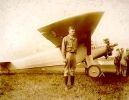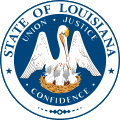 | Find Louisiana State Museum on Facebook |
 | Find Louisiana State Museum on Twitter |
| 2016 Sunset Report |
| OLG & DCRT Strategic Plan 2020-21 through 2024-25 |

- Quality - Louisiana State Library
85% of the users of the State Library indicated that the State Library's services and resources was a good value for the State.Source: The Impact of the Louisiana Department of Culture, Recreation and Tourism on Louisiana's Economy and Quality of Life for Louisiana's Citizens - June 2006
- Louisiana's deep water ports
Did you know that Louisiana's five deep water ports handle more than 457 million tons of U.S. waterborne commerce a year? - Quality - Louisiana State Library
85% of the users of the State Library indicated that the State Library's services and resources was a good value for the State.Source: The Impact of the Louisiana Department of Culture, Recreation and Tourism on Louisiana's Economy and Quality of Life for Louisiana's Citizens - June 2006
- Atchafalaya Heritage Area
The Atchafalaya Heritage Area has been designated by Congress as a National Heritage Area.
- Impact - DCRT Returns Investment Dollars to Louisiana
For every state tax dollar spent by the Department of Culture, Recreation and Tourism, $5.86 is returned to the State Treasury and citizens of Louisiana.Source: The Impact of the Louisiana Department of Culture, Recreation and Tourism on Louisiana's Economy and Quality of Life for Louisiana's Citizens - June 2006
- Impact - Louisiana Office of Tourism Tops Returns on Investment
$13.90 is the return on investment for every dollar spent by the Office of Tourism. Over 175,000 people were directly employed by the Louisiana travel and tourism industry in 2004. In terms of production, $5.9 billion (3.8%) of Louisiana's Gross State Product was directly attributable to expenditures by visitors to LouisianaSource: The Impact of the Louisiana Department of Culture, Recreation and Tourism on Louisiana's Economy and Quality of Life for Louisiana's Citizens - June 2006
- Impact - Supporting the Louisiana Arts
Every dollar in state support for the Arts leverages $7 in earned and contributed revenue. Louisiana's cultural enterprises provide nearly 144,000 jobs for Louisiana citizens, accounting for 7.6% of total employment. Arts has a total economic impact of $934 million in Louisiana.Source: The Impact of the Louisiana Department of Culture, Recreation and Tourism on Louisiana's Economy and Quality of Life for Louisiana's Citizens - June 2006
- Impact - Visitors Generate State Revenue
In terms of tax revenues, visitor spending accounted for $677 million of 2004 Louisiana revenues, or 8.3% of the total 2004 State Budget.Source: The Impact of the Louisiana Department of Culture, Recreation and Tourism on Louisiana's Economy and Quality of Life for Louisiana's Citizens - June 2006
- Quality - Louisiana State Museums
95% of State Museum's visitors strongly agreed or agreed that the State Museum was an educational experience and has expanded their awareness of Louisiana's cultural history.Source: The Impact of the Louisiana Department of Culture, Recreation and Tourism on Louisiana's Economy and Quality of Life for Louisiana's Citizens - June 2006
- Quality - Historic Preservation and the Arts
78-80% of Louisiana residents believe that historic preservation and arts are important and should be high priorities.Source: The Impact of the Louisiana Department of Culture, Recreation and Tourism on Louisiana's Economy and Quality of Life for Louisiana's Citizens - June 2006
- Impact - Louisiana Serve Program
The Louisiana Serve Program in the Office of Lieutenant Governor returns 2.8 million in non-state revenue to Louisiana. - Impact - Louisiana State Museum
The Office of State Museum returns $6.99 for every tax dollar spent.Source: The Impact of the Louisiana Department of Culture, Recreation and Tourism on Louisiana's Economy and Quality of Life for Louisiana's Citizens - June 2006
- Impact - Louisiana State Parks
Visitor spending at Louisiana State Parks returns $3.23 in state taxes for every dollar spend on operating and maintaining all our beautiful parks. Out-of-state visitors to Louisiana State Parks spent almost $12 million in Louisiana and produced an economic impact of over $24 million. Louisiana residents spent another $29.2 million while visiting the parks.Source: The Impact of the Louisiana Department of Culture, Recreation and Tourism on Louisiana's Economy and Quality of Life for Louisiana's Citizens - June 2006
- Impact - Scenic Byways Program
The Scenic Byways program leverages $1.56 for every dollar spent by the program.Source: The Impact of the Louisiana Department of Culture, Recreation and Tourism on Louisiana's Economy and Quality of Life for Louisiana's Citizens - June 2006
- Louisiana State Parks and the National Register
Thirteen Louisiana State Parks sites are on the National Register of Historic Places. They include:
• Audubon State Historic Site
• Centenary State Historic Site
• Fort Pike State Historic Site
• Fort Jesup State Historic Site
• Longfellow-Evangeline State Historic Site
• Mansfield State Historic Site
• Marksville State Historic Site
• Plaquemine Lock State Historic Site
• Port Hudson State Historic Site
• Poverty Point State Historic Site
• Otis House at Fairview-Riverside State Park
• Rosedown Plantation State Historic Site
• Winter Quarters State Historic Site - Louisiana State Parks Visitation
Nearly two million people visited a Louisiana State Park last year. - Louisiana State Parks Grow and Renew
The Louisiana Office of State Parks has spent nearly $80 million in major construction projects since 2004, providing two brand-new parks and a new historic site, adding cabins and campsites to existing parks and building visitor center at one park, the preservation area and three historic sites. - Louisiana State Parks Wireless Internet
The Louisiana Office of State Parks provides free wireless internet access at all 20 recreational parks. Extensive coverage areas include most cabins, RV slips and campsites. - Louisiana State Parks Online Reservations
You can now make online reservations for cabins, campsites, lodges and group camps – at www.ReserveLaStateParks.com - Louisiana State Parks Honors National Parks Service Senior Pass Program
Visitors who hold an America the Beautiful Senior or Access Pass, and whose home State Park system honor the America the Beautiful passes for camping discounts, are entitled to a 50% reduction on camping fees at Louisiana State Parks. Certain restrictions apply, see State Parks' fees & facilities page for more information. - Louisiana State Parks Draw Media Attention
Louisiana State Parks sites have been featured in movie and television releases including "True Detective," CBS’ "Zoo," and "NCIS: New Orleans," "G.I. Joe: Retaliation," "Selfless," "Devil’s Due," and commercials for Popeyes and Toyota. - Capitol Park Welcome Center
The main meeting room in the Capitol Park Welcome Center is named after Margaret Taylor, wife of U.S. President Zachary Taylor. The couple resided in a small house near the present day location of Capitol Park until Taylor was elected to the Presidency.
| Table of Contents | Early Aviation in LA | The Williams Family | Jimmie and Walter Wedell | Patterson Airport | Selected Bibliography |
The 1910 New Orleans Aviation Tournament
The new daredevils captured the attention of the entire country, and Louisiana was no exception. While many marveled at the very act of flying, others quickly saw business potential. In New Orleans a committee under the leadership of Crawford H. Ellis envisioned aviation not only as a new tool for business, but also as an excellent way of promoting the city itself. In 1910 they followed the lead of other cities and invited the world’s most eminent aviators to New Orleans for a tournament. The meet, scheduled for Christmas Eve until January 2, promised $10,000 in prizes.
The heralded "birdmen," as they were called, and their airplanes arrived in New Orleans, not by air, but by train. The most famous of the group were John B. Moisant, an American of French Canadian descent, and his mascot kitten, Paris-Londres, who had accompanied him on a recent flight from Paris to London. Moisant immediately captured the hearts of New Orleanians when he made an unscheduled flight over the city for 46 minutes and 10 seconds, breaking the world’s record for the longest flight over a city. Thousands watched as he performed spirals over Lafayette Square. For over a week, spectators turned out at City Park to watch aviators perform stunts and attempt to break altitude, speed, and duration records. In a Blériot monoplane French aviator René Simon broke the world’s record for one mile in 57 seconds. In a land-air race with an automobile, Moisant came in a close second.
The meet came to a tragic end on December 31 when Moisant crashed in Harahan, just outside of New Orleans, as he prepared to compete for the Michelin Cup, awarded annually for the longest continuous flight. In 1946 the new international airport in Kenner was named in his honor.
The Airmail Route
Promoters of air travel hoped to establish the industry through a demonstration of its practical uses. They found a likely target in the mail system. In 1912, more than a dozen years before airmail became a regular service, French aviator George Mestach delivered mail from New Orleans to Baton Rouge in 1 hour and 32 minutes, marking the second airmail delivery in the United States. Although he ran into a fence and broke the plane’s propeller upon landing on the Louisiana State University campus, the jostled Mestach managed to deliver a letter to Governor J. Y. Sanders.
Businessmen viewed aviation as a tool for securing trade and commerce with countries abroad, especially in Central and South America. In the 1920s such boosters as the New Orleans Chamber of Commerce and the Young Men’s Business Club (YMBC) campaigned for federal airmail service and promoted aviation activities. In 1925 the YMBC constructed Alvin Callender Field, named after the only New Orleans pilot to be killed in World War I.
In 1923 New Orleans became one of two cities in the United States to test the effectiveness of incorporating air delivery for foreign mail. The government awarded the contract to World War I veteran Arthur Cambas, who hired former naval aviators and formed New Orleans Air Line. Departing from a hangar at the end of Poland Avenue, seaplanes brought mail from New Orleans to Pilot Town at the mouth of the Mississippi River, allowing mail bound for South America to reach steamers twelve hours after they left New Orleans. The service also brought mail from incoming ships into the city.
Airmail service expanded in 1928, when the federal government selected St. Tammany–Gulf Coast Airways to provide delivery from New Orleans to Mobile, Birmingham, and Atlanta. From there, another plane would carry mail to New York. On May 1, 1928, the first plane left Alvin Callender Field in Belle Chasse with 12,000 pieces of mail weighing 196 pounds.
Lindbergh Visits New Orleans
Just a few months after Charles Lindbergh became the first pilot to complete a transatlantic flight, he visited New Orleans as part of his nationwide effort to promote aviation. He flew into New Orleans at Callender Field in the Spirit of St. Louis, the same plane he flew across the ocean. The city enthusiastically welcomed the hero: 15,000 schoolchildren gathered for his appearance at Tulane Stadium, and 700 civic leaders attended a banquet at the Tip Top Room of the Roosevelt Hotel. Three years later, another famous aviator, Amelia Earhart, visited the city.
 Lindbergh with Spirit of St. Louis |  Lindbergh working on plane |

